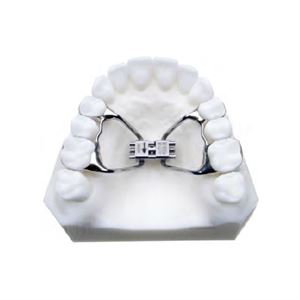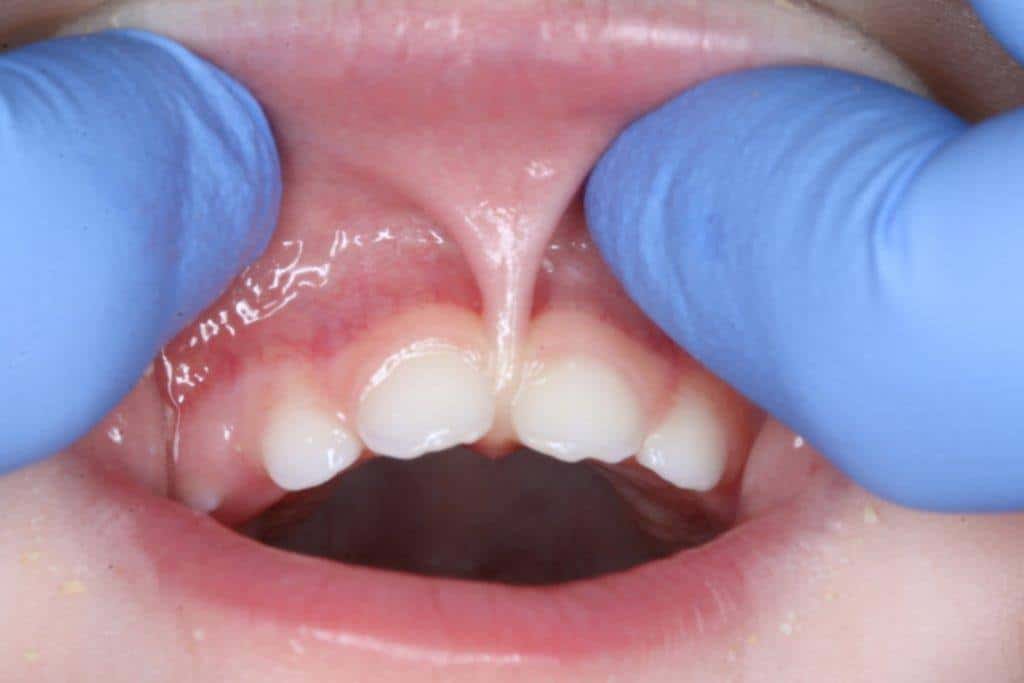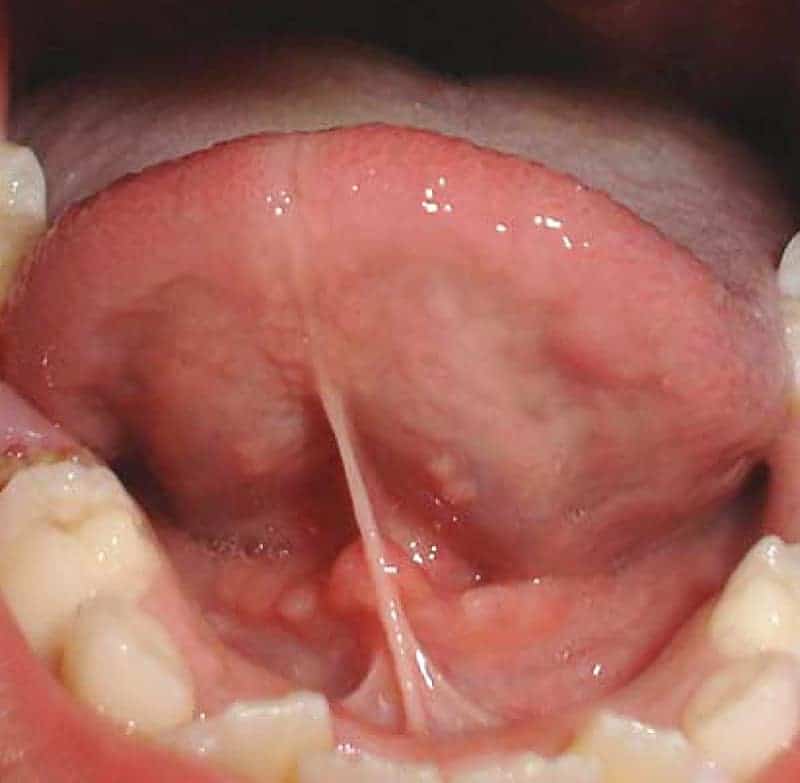What is the Advanced Lightwire Functional ALF Appliance?
The ALF is a light springy wire that is temporarily fixed to the back side of the upper teeth. The ALF device supplies and outward pressure that is increased by tongue pressure during swallowing, eating and talking. The ALF produces the perfect conditions for gentle facial growth in adults and kids. The ALF is a gentle alternative to conventional braces. ALF therapy works better when combined with myofunctional therapy and tongue tie releases when necessary.

ALF Appliance
What Causes Natural Maxillary Palatal Expansion?
The main driver for jaw growth and development is the tongue. The tongue during normal function such as talking, swallowing, etc., puts an outward pressure on the teeth and jawbones. In a growing child, pressure on jaw bone by the tongue is the stimulus for natural maxillary expansion. When conditions such as tongue and lip ties are present, the range of motion of the tongue is decreased as is the pressure placed by the tongue on growing jaws. The biggest culprit in jaw under development and crowded teeth is tongue not doing is job and lip ties holding jaw development back.
The ALF Corrects Teeth Crowding
What can be done when teeth are crowded, crooked and the facial profile is poor? Dr. Adams uses the ALF appliance in many of these cases. The ALF is also called the advanced light wire functional. Long story short, the ALF is a great alternative to braces when it comes to straightening kids teeth. Because the appliance will create room by stimulating growth of the jaws and teeth have more room to fit. An ALF appliance has five very important benefits when your child’s development is growing askew and teeth are getting crowded and crooked:
- Stimulate an increase in outward growth of the jaws. creates more space for the teeth to fit.
- Creates more room for the tongue to fit and function properly in the mouth.
- Promotes proper size, shape and dimension to the jaws top to bottom
- Creates balance and symmetry between the jaws and other facial bones
- Creates a better fit of the teeth and a better bite.
- Increases the volume of space in the mouth and nasal passageways
ALF Appliance was invented by Dr. Nordstrom in the 1980s
The ALF appliance can make a smile look better and prevent many of the causes of TMJ, sleep apnea, orthodontic problems and postural problems. Where braces can retract teeth and more them backwards, the ALF can stimulate an increase in space in the mouth for teeth to fit into a more favorable position.
If your child breathes loudly, snores, clenches his/her teeth at night time, suffers from nasal stuffiness, these are warning signs of underlying problems. some children even have sleep apnea. Creating more size and space in the jaws and mouth increases the space available for breathing and tongue function. It is all connected-the link between straight teeth, proper spaces in the mouth, upper airway. It is where form meets function and life. That is holistic orthodontics. There are many different palatal expander and growth appliance options used by Dr. Adams. There is not a best appliance, but rather one that promotes the growth needed by the patient.
Meet Dr. Adams
Dr. Adams is a holistic dentist by philosophy. He has been treating kids and adults with advanced light wire functional appliances for years. The ALF is commonly used for improving jaw and bite balance. And the device is also promotes palatal expansion and better airway flow through the mouth. Night time breathing issues is one of the biggest causes of heart disease and sleep apnea. “my job is to treat the hole body and not only repair and replace teeth but to also prevent future tooth loss by diagnosing and correcting the root cause…” Dr. Adams sees patients in his Burtonsville office near Columbia Maryland and Silver Spring MD.

dr gary adams small 1
ALF appliance Video
Lip ties and Frenums Limit Face and Jaw Growth
Lip ties tighten the lips back on the teeth and produce a resistance to anterior growth of the jaws and face. Proper function of the tongue is pivotal to successful ALF treatment. Therefore treatment of tongue ties with myofunctional therapy and tongue and lip tie release is necessary for success. In general, the reviews for ALF orthodontic appliances are great and the results are superb for kids with teeth crowding and crooking.
The ALF is the go to appliance for kids with crowded teeth, but it is also a great craniofacial device for adults who have minor tooth crowding and who could use some jaw and facial balancing. The Vivoslife DNA is a much better appliance for adults who have TMJ, posture, headaches and sleep apnea problems. The DNA device produces more growth of bone in adults and enables the DNA appliance provider to place the patient into a different bite and better treat TMJ pain quickly.
How Much Does The ALF Appliance Cost
ALF appliance treatment usually lasts 6 – 18 months. It includes a 3D xray, full evaluation and diagnosis, treatment plan, upper a lower ALF appliances. The therapy includes monthly adjustments and visits to see Dr. Adams. The child must do their ALF tongue exercises daily. The cost for the entire therapy is all inclusive and costs between $4000 – $6000 depending on the complexity of the cas
Is the Advanced Light Wire a Palatal Expander?
The Advanced Lightwire is really a palatal expander that uses the aid of a functional force. The tongue and chewing forces are the forces used in ALF palatal “expansion” therapy. We are not sure where the word “expansion” came from in the world of dentistry, but is sounds scary…what really happens is targeted stimulation of jaw bone growth with the aid of natural function forces – the tongue. The tongue is the natural palatal expander. The ALF promotes a natural increase in bone volume and jaw space. The new space allows additional room for teeth to fit and the tongue to function normally. Successful ALF treatment in this regard is what prevents TMJ problems and sleep apnea in adulthood.
Braces compared to ALF
Braces work well to straighten crooked teeth as long as there is enough room in the jaw for the teeth to all fit. If there is not enough room, expanders are necessary. Braces can be used after dental expanders to correct crooked teeth, spacing and other cosmetic issues. Often times there is not a need for braces after the ALF. Spaces and minor bite issues often self resolve 3-6 months after being treated with an expander.
Is the ALF an Alternative to Braces?
In our opinion, The ALF is a better appliance for correcting tooth crowding because the ALF creates room for the tongue and the teeth to fit in the mouth. The ALF also results in the jaw being the shape of the tongue rather than shaped as a wire or another appliance that does not use functional tongue forces. The ALF expansion stops when the tongue stops pushing outward on the appliance and teeth – that is at the time the tongue has enough room to function properly. As if it were magic, the human mouth is designed to be large enough to fit all the teeth and tongue – naturally when teeth have enough room to fit, so does the tongue. This is the way things were naturally intended to be. The ALF is truly a natural expander. While using the ALF appliance therapy, a craniofacial dentist can slowly adjust the omega loops on the wire to slowly increase the diameter of the ALF. By increasing the profile of the appliance, the result is a lightwire force of pressure and stimulation of outward and jaw regeneration. Promotion of a larger jaw creates more tongue space, more room for the teeth to fit better and more room for better night-time breathing.
The ALF is the goto appliance for kids with crooked and crowded teeth. The ALF has also been shown to reverse the effects of poor facial development, facial damage caused by traumatic birth, some TMJ pain, and pain and facial damage caused by aggressive retractive extraction orthodontics. The ALF can also correct facial asymmetries, produce palatal expansion, and open the Airway.
Slow Palatal Expansion (SPE) vs Rapid Palatal Expander (RPE)
The ALF uses light forces and the appliance is shaped like a mouth and tongue are shaped. A rapid palatal expander uses a screw to do all the expansion and most of the time only expands in the back of the top maxillary jaw. The result can often be tipping of the teeth and a V-shaped mouth. The two main problems with rapid palatal expansion:
- Expansion does not occur in the front part of the upper jaw
- Expansion is too fast and less bone grows and sometimes teeth move and tip. In cases where more palatal expansion is needed, a Crozat expander or a Schwarz appliances should.
Naturally there is tooth crowding in a small mouth. Crowding of teeth is usually treated as a cosmetic problem in orthodontics. Children who have small mouths and crowded teeth may have breathing problems through their mouths and noses and may sleep poorly. Pediatric sleep apnea appliances and holistic orthodontists can be hard to find. Often there is too much focus in cosmetics and straight teeth.

rapid palatal expander 111w
Benefits of ALF Orthodontics:
- Corrects Crowding of Teeth by creating more room in the mouth for the teeth to fit side-by-side.
- Achieves Expansion in the natural shape of the mouth
- Decreases or Eliminates the need for complex orthodontics and braces
- Improves tongue position and function
- Improves the size of the airway (mouth and nose)
- Improves sleep
- Decreases TMJ disorder
- Improves bite or occlusion
- Improves nose breathing
- Improves sinus drainage
- Improves overall symmetry of the jaw bones
- Improves posture
TMJ Pain is Linked to Sleep Apnea and UARS
The ALF is an “Elgiloy” wire of 0.025” or 0.028”. The advanced lightwire functional has a high degree of flexibility. ALF can be adjusted to increase the size of the upper and lower jaws. ALF was originally designed and created by Dr. Nordstrom in the 1980s. The ALF appliance uses the tongue ( “functional force” ) and strategic adjustments by the dentist to correct tooth crowding by producing a “light” outward force to promote jaw bone growth.
Schedule Consultation


 (301) 421 1996
(301) 421 1996 burtonsvillesmiles@gmail.com
burtonsvillesmiles@gmail.com

